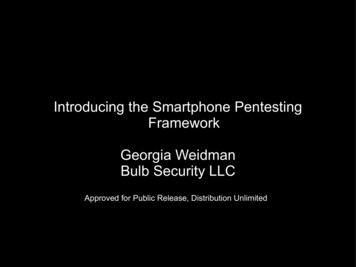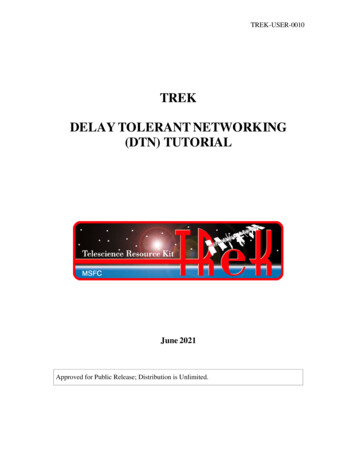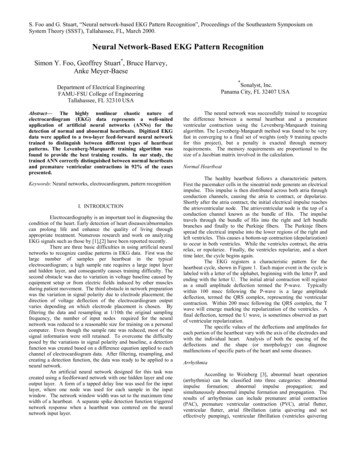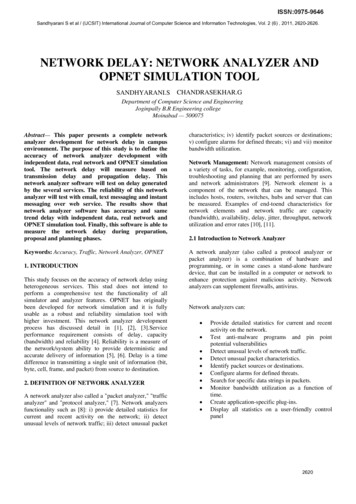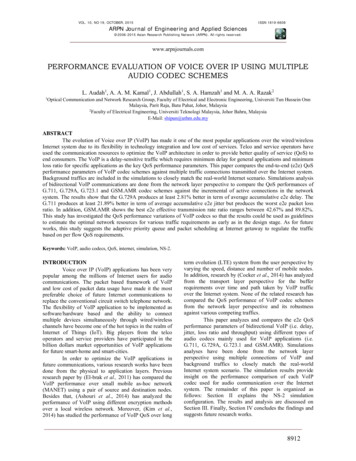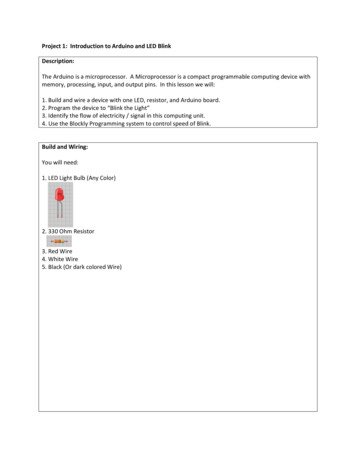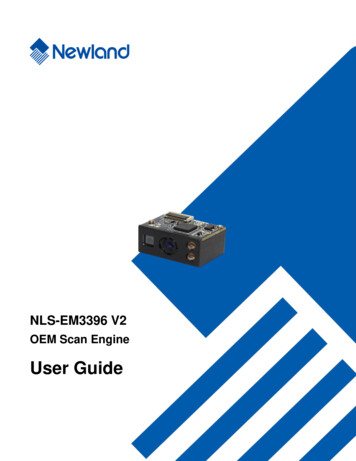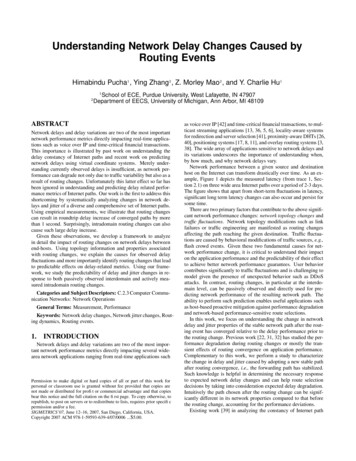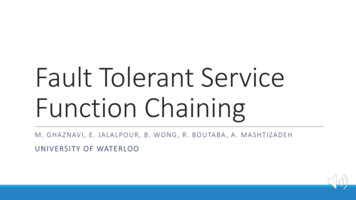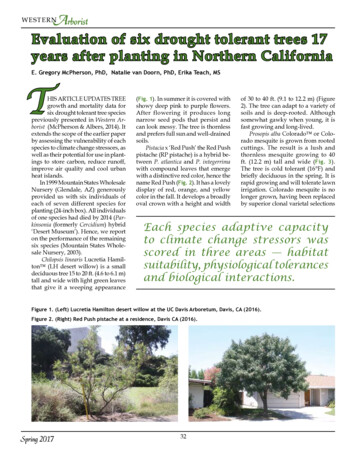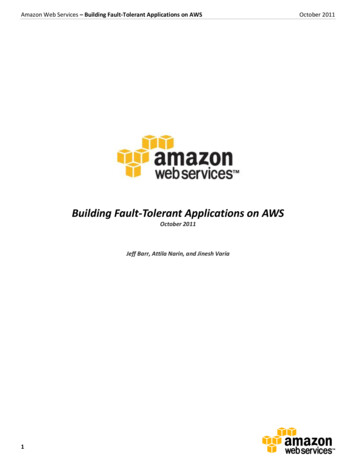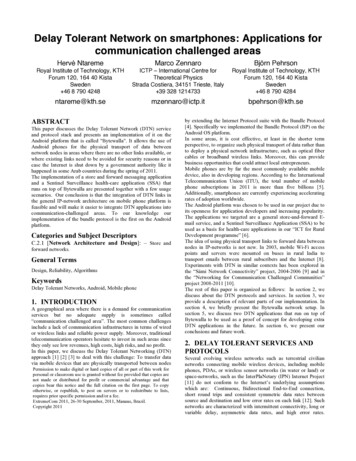
Transcription
Delay Tolerant Network on smartphones: Applications forcommunication challenged areasHervé NtaremeMarco ZennaroBjörn PehrsonRoyal Institute of Technology, KTHForum 120, 164 40 KistaSweden 46 8 790 4248ICTP – International Centre forTheoretical PhysicsStrada Costiera, 34151 Trieste, Italy 39 328 1214733Royal Institute of Technology, KTHForum 120, 164 40 KistaSweden 46 8 790 BSTRACTThis paper discusses the Delay Tolerant Network (DTN) serviceand protocol stack and presents an implementation of it on theAndroid platform that is called "Bytewalla". It allows the use ofAndroid phones for the physical transport of data betweennetwork nodes in areas where there are no other links available, orwhere existing links need to be avoided for security reasons or incase the Internet is shut down by a government authority like ithappened in some Arab countries during the spring of 2011.The implementation of a store and forward messaging applicationand a Sentinel Surveillance health-care application (SSA) thatruns on top of Bytewalla are presented together with a few usagescenarios. Our conclusion is that the integration of DTN links inthe general IP-network architecture on mobile phone platform isfeasible and will make it easier to integrate DTN applications intocommunication-challenged areas. To our knowledge ourimplementation of the bundle protocol is the first on the Androidplatform.Categories and Subject DescriptorsC.2.1 [Network Architecture and Design]: – Store andforward networks.General TermsDesign, Reliability, AlgorithmsKeywordsDelay Tolerant Networks, Android, Mobile phone1. INTRODUCTIONA geographical area where there is a demand for communicationservices but no adequate supply is sometimes called“communication challenged area”. The most common challengesinclude a lack of communication infrastructures in terms of wiredor wireless links and reliable power supply. Moreover, traditionaltelecommunication operators hesitate to invest in such areas sincethey only see low revenues, high costs, high risks, and no profit.In this paper, we discuss the Delay Tolerant Networking (DTN)approach [1] [2] [3] to deal with this challenge: To transfer datavia mobile devices that are physically transported between nodesPermission to make digital or hard copies of all or part of this work forpersonal or classroom use is granted without fee provided that copies arenot made or distributed for profit or commercial advantage and thatcopies bear this notice and the full citation on the first page. To copyotherwise, or republish, to post on servers or to redistribute to lists,requires prior specific permission and/or a fee.ExtremeCom 2011, 26-30 September, 2011, Manaus, Brazil.Copyright 2011by extending the Internet Protocol suite with the Bundle Protocol[4]. Specifically we implemented the Bundle Protocol (BP) on theAndroid OS platform.In some areas, it is cost effective, at least in the shorter termperspective, to organize such physical transport of data rather thanto deploy a physical network infrastructure, such as optical fibercables or broadband wireless links. Moreover, this can providebusiness opportunities that could attract local entrepreneurs.Mobile phones are by far the most commonly available mobiledevice, also in developing regions. According to the InternationalTelecommunication Union (ITU), the total number of mobilephone subscriptions in 2011 is more than five billions [5].Additionally, smartphones are currently experiencing acceleratingrates of adoption worldwide.The Android platform was chosen to be used in our project due toits openness for application developers and increasing popularity.The applications we targeted are a general store-and-forward Email service, and a Sentinel Surveillance Application (SSA) to beused as a basis for health-care applications in our “ICT for RuralDevelopment programme” [6].The idea of using physical transport links to forward data betweennodes in IP-networks is not new. In 2003, mobile Wi-Fi accesspoints and servers were mounted on buses in rural India totransport emails between rural subscribers and the Internet [8].Experiments with DTN in similar contexts has been explored inthe “Sámi Network Connectivity” project, 2004-2006 [9] and inthe “Networking for Communication Challenged Communities”project 2008-2011 [10].The rest of this paper is organized as follows: In section 2, wediscuss about the DTN protocols and services. In section 3, weprovide a description of relevant parts of our implementation. Insection 4, we briefly present the Bytewalla network setup. Insection 5, we discuss two DTN applications that run on top ofBytewalla to be used as a proof of concept for developing extraDTN applications in the future. In section 6, we present ourconclusions and future work.2. DELAY TOLERANT SERVICES ANDPROTOCOLSSeveral evolving wireless networks such as terrestrial civiliannetworks connecting mobile wireless devices, including mobilephones, PDAs, or wireless sensor networks (in water or land) orspace-networks, such as the InterPlaNetary (IPN) Internet Project[11] do not conform to the Internet’s underlying assumptionswhich are: Continuous, Bidirectional End-to-End connection,short round trips and consistent symmetric data rates betweensource and destination and low error rates on each link [12]. Suchnetworks are characterized with intermittent connectivity, long orvariable delay, asymmetric data rates, and high error rates.
Therefore, connecting them to the Internet requires theintervention of a service that can translate between incompatiblenetworks characteristics and which can provide a buffer formismatched network delays. The Delay-Tolerant Networking(DTN) helps to address the above mentioned technical issues.3.2 Software components overviewThe DTN concept was first conceived within the Inter-PlanetaryNetwork Research Group charter (IPNRG) of the InternetResearch Task Force (IRTF), to deal with the challenges in highdelay environments. The DTN architecture defines an overlaylayer on top of the TCP/IP architecture between the transport andthe application layer of the network on which it is hosted. Thislayer forms an overlay that uses persistent storage to solvenetwork interruption related problems and provides functionalitiessimilar to the Internet layer described in the originalARPANET/Internet designs.DTNService is a backend transparent application serving DTNcommunication. Therefore, even though the user decides to useother applications such as to make a phone call or read textmessages, he can still send/receive DTN bundles. To be able torun in backend in the Android platform, this component isimplemented as Android Service [14]. This component uses theTCP/IP stack of the Android platform to achieve networkcommunication. Because DTNService is running in backend,there is a need for a user interface to interact with the service. Thisis the reason why the DTNManager module is needed. It is a frontend application for the user to configure, monitor, and manage theDTNService module. This front end application is designed as anAndroid Activity [15].The overlay network approach is represented by the BundleProtocol (BP) (RFC5050). The basic idea is that each packettransmitted is called a “bundle” and contains all of the signalingas well as the data required to transit the transport layer which isreferred to as the bundle convergence layer. Therefore, the bundlearchitecture operates as an overlay network, whereby DTN nodesare identified by Endpoint Identifiers (EIDs), which are thebundling equivalent of addresses. Bundles are routed in a storeand forward manner between participating nodes over variednetwork transport technologies (including both IP and non-IPbased transports).Other DTN protocols include the Licklider Transmission Protocol(LTP) which is a point-to-point protocol designed to be a potentialconvergence layer to support the bundle protocol, though it canalso be used in other contexts. It is primarily designed for the truehigh-latency case of deep space communications; to be usable as aconvergence layer for the bundle protocol. But it can also be usedabove traditional connectionless transport layer like UDP interrestrial contexts, including sensor networks using data mules.[13].DTN are frequently used in disaster relief missions, peacekeeping missions, and in vehicular networks. Moreover, NASAhas tested DTN technology for spacecraft communications.3. IMPLEMENTATION3.1 Bytewalla network architectureThe Bytewalla network architecture consists of two networkswhich can be deployed to interoperate from two separate remotelocations.Figure 1: Bytewalla Network ArchitectureA practical scenario would be to deploy one network in a ruralvillage which lacks Internet connection and the other network in acity where there is broadband Internet connection as illustrated inFigure 1.There are three software components in the implementation:DTNService, DTNManager, and DTNApps. These componentsinteract with each other and with the Android TCP/IP stack. Theinteractions are illustrated in figure 2.DTNApps are the applications running on top of the DTNService.Two sample DTN applications developed are DTNSend andDTNReceive. DTNSend is a DTN application allowing users tosend text messages over DTN. DTNReceive is a DTN applicationallowing users to receive text messages over DTN. Because bothof them are front end applications similar to DTNManager, theyare mapped to the Android activity.Figure 2: Software components overview3.3 DTN internal design summaryThe internal design of DTNService follows the design andworking principles of DTN2 [16], which is the DTN referenceimplementation developed in C by the Delay Tolerant NetworkResearch Group (DTNRG). Therefore, the design has similarcharacteristics as the reference implementation by which itfollows a modular design. This allows the system to be upgradedeasily by adding extra functionalities.The design of DTNService is composed of nine modules whichare: Bundle Daemon, Contact Manager, TCP Convergence Layer,Discovery, Persistent Storage, Registration, Bundle Router,Fragmentation manager and APILib. DTNService is an eventdriven system. There are several types of events, such as, bundlereceiving event, bundle transmitted event, or contact initiationevent. The system works according to the event handlingfunctions defined in event handling components including BundleDaemon, Bundle Router, and Contact Manager. Thecommunication among the different modules is illustrated infigure 3. The arrows represent the communication between eachmodule
the routing is handled by the PRoPHET algorithm [19] which isused to make the route decisions for the outgoing bundles.3.3.8 Fragmentation ManagerThe Fragmentation manager module task is to fragment largebundles. It keeps the state of all the fragmented bundles andpartially received bundles. Then, it reconstructs the bundle fromthe received fragments.3.3.9 APILibFigure 3: Internal design summary.3.3.1 Bundle DaemonBundle daemon is the main event handler of the system. It is thecentral processing unit and responsible for communicating withother module for processing the bundle event. Every bundle eventis checked first by the daemon. If the Bundle Daemon determinesthat other two event processing components including BundleRouter and Contact Manager should process the event as well, itforwards the event to these components. Otherwise, it removes it.3.3.2 TCP Convergence layerTCP Convergence Layer [17] is the transport mechanism overTCP that the DTN application uses to transmit bundles to a nexthop.3.3.3 DiscoveryDiscovery is the method by which other nodes can be aware of the"existence” of other DTN participant nodes and their addresses[18]. Discovery is based on the IP protocol; each node sends andlistens IP UDP announcements "to discover" remote neighbors.Once a node is discovered, the Bundle Daemon together with theContact Manager creates a link for that node.The APILib module provides an Application ProgrammingInterface (API) to develop a DTN application on the Androidplatform. The API communicates with the bundle daemon moduleto achieve the API call. This is the channel that is used by othercomponents such as DTNApps to access the DTNService module.This component is implemented by the Android Binder class ofthe Android APIs.4. NETWORK SETUPThe network setup is accomplished in four steps which are:a.b.c.d.Install the required software on the two remote servers:o Ubuntu Linux and Oracle Berkeley DBoOASYS software (Object-oriented Adaptors to SYSteminterfaces), DHCP server and The DTN2 software.Install the Bytewalla application on the Android phone [20].Install and configure WIFI access points on the two servers.Configure the three nodes to send and receive DTN Bundles.5. APPLICATIONS5.1 The Android mobile phone applicationThe Bytewalla application has two applications to send andreceive data bundles from inside the mobile application. Figure 4illustrates the GUI of the application.3.3.4 Contact ManagerContact Manager is the service in charge of detecting newopportunities of connections. Each opportunity of connection("opportunistic link") with a neighbor ("contact") is under thecontrol of Contact Manager which also does the scheduling of thelinks. One of the main tasks of this module is to manage theavailability of links and contact; this is made by posting events inthe Bundle Daemon. Other main tasks are to provide the contactinformation to the Bundle Router and the linkage to theunderlying module “TCP Convergence Layer”.Figure 4: Application exampleThe configuration part consists of four sections:3.3.5 Persistence storagea.Persistent storage is the storage mechanism that stores dataobjects on the disk. Persistent storage is a generic implementationso that it can store different types of objects in the database.3.3.6 RegistrationThis module handles the specified registration created from theBundle Daemon. Every bundle received by the daemon is checkedwith this module and if it is matched, it is delivered to theregistration for further processing.3.3.7 Bundle routerThe Bundle router module is the main decision maker in regard toforwarding the bundles to the destination. In this implementationb.c.d.Storage section: In this section the user can define the typeof the service to be used for storing the bundles which couldbe the SD card of the phone. Moreover, the amount ofmemory to be used can be set.Interfaces section: This section refers to the listenerinterface of the application. It consists of three fields: ID,type of convergence layer and local port. The type ofconvergence layer used is TCP.Link section: This section includes the information neededto start a connection to the DTN servers.Routing section: Bytewalla supports both static anddynamic routing.
5.2 E-mail applicationThe E-Mail application is used to send E-mail messages fromusers who are based in a remote village without Internetconnection5.2.1 DTN E-mail integrationThe servers receive emails from the clients and convert the emailsinto bundles and vice versa. The bundles are forwarded to theAndroid phones and transported physically from one location toanother. They are delivered on the DTN server when a phoneenters in contact with it.Figure 5: Village protocol deploymentFigure 5 describes the village protocol deployment which consistsof a Sender/Receiver, a DTN Mail Proxy Server, and an Androidphone. The DTN Mail Proxy Server in the village protocolcontains a DTN mail Interface. The sender sends a mail through aMUA which communicate with the MTA/MDA by the SMTPprotocol which in turn forwards the mail to the DTN mailInterface. Then, the mail is transferred to DTN software. Then, theDTN software sends the email to the Android phone’s DTNsoftware through the Bundle Protocol. The reverse procedurehappens when a user in the village receives an E-mail. The IMAPserver is used to deliver the Email to the village MUA. A DHCPserver allocates dynamic IP addresses to the sender/receiverdevice and the Android phones.access to authenticated users to avoid illegal data manipulation atboth sending and receiving sites.It is a server side web based application which uses a set of basicopen source services and software. The list below describes theservices and software required in order to run the SSA.a. DTN Daemon: It is based on DTN2 software.b. Database: MySQL is used to store patient’s records.c. Web Server: Apache 2 web serverd. Cron: A Linux based schedulere. Domain Name Service: Bind9Figure 7: Architecture of the SSA applicationThe SSA consists of “SSA send” and “SSA receive” applicationswhich are used to send and receive the records. The “SSA send” isexecuted when a user enters a record in the application. “SSAreceive” is required to execute regularly in order to fetch therecords. The design of SSA send is illustrated in the figure 8 anddescribed below.Figure 8: SSA sending processa.b.c.d.e.Figure 6: City protocol deploymentThe city protocol is similar to the village protocol except that theMTA/MDA of both the DTN mail gateway server and target mailsystem communicates through the SMTP protocol over Internetboth for sending and receiving emails. The communicationbetween the DTN Mail gateway server and the Android phonesare the same as in village protocol as it is described in figure 6.5.3Sentinel Surveillance Application (SSA)The goal of the SSA is to provide a facility to report medicalrelated data such as the level of the stock of medical drugs ornumber of patients in a village to a healthcare authority located inanother remote region such as a city by using the Bytewalla DTNnetwork. The SSA needs to reside on both sites; the city and thevillage, as records are maintained in the databases. It providesf.A user interacts with the system using a web interface.SSA sender collects data from the user and stores it in thedatabase.SSA sender writes the same record in a text file with a timestamp.SSA sender transfers the text files to the DTN Daemon.The DTN daemon builds the bundle out of the text file.The bundles reside in a bundle data store and handed over toan Android phone when it passes nearby the site.The design of the “SSA receive” application follows almost asimilar process in receiving the records as described below and asillustrated in figure 9.a. The Android phone transfers the bundles to the DTN daemonand the data is stored in DTN data store.b. SSA receiver is invoked by Cron scheduler.c. SSA receiver scans the DTN data store to fetch the records.d. “SSA receiver” reads and stores the records in a database.e. “SSA receiver” backs up the bundle received from theBytewalla Android phone.f. “SSA receiver” logs all the performed activities.
Figure 9: SSA reception process.6. PERFORMANCE MEASUREMENTSThe test environment consists of two Ubuntu desktop serverswhich runs DTN2 and an HTC Tattoo Android phone as describedin figure 5.105 DTN bundles were generated to be routed between the twoservers. 35 different sizes of bundles were generated with theinitial bundle size measuring 100KB. Each of the remainingbundle size was incremented by 100KB. So the size of the last 3bundles was 3.5MB.Fig 7: Upload bandwidthThe bandwidth analysis for upload time is shown in figure 7. Thebundles were sent from the Android phone to the other server. Asexpected, the upload time increased linearly with the increase ofbundle size. An average value for the upload bandwidth is asfollows: The average upload bandwidth equals to the TotalBundle Size / Total Upload Time which is 60.29 KB/S.A comparative study between the download and uploadbandwidth is shown in figure 8. For small bundles of size 100 KB,the download and upload times are identical. Up to the bundle sizeof 1.5MB, there is a very small difference in upload and downloadtime. After that, the difference increases as the download timeincreases. A significant observation made from this figure is thatthe download time is always higher than the upload time.6.1 Bandwidth analysisThe time for downloading 105 bundles is shown in figure 6. Therewas 189013.1 KB of data in total. In this case the bundles weredownloaded from the server to the Android phone. The graphshows a linear increase in download time with the increase ofbundle size.Fig 8: Comparison between download and upload bandwidth6.2 Power consumption analysisThe battery consumption was recorded with a fully chargedbattery of HTC tattoo phone. The 105 bundles had a total size of184.68 MB. Figure 9 shows the cumulative battery consumptionfor downloading the bundles. No other applications were runningduring the period the data were being recorded. This ensured thebattery power was consumed only by the DTN software.Fig 6: Download bandwidthThis follows a linear equation of the general form y mx b. Thisis expected because while downloading the bundles, there were noother download activities running which can consume thebandwidth. The average download bandwidth equals to the TotalBundle Size / Total Download Time, which is 51.36 KB/s.Fig 9: Cumulative battery consumption for downloadThe battery consumption rate was high for first 22 MB of data.But after that there was a drop in battery consumption till 75 MBsize of data. Then, there is a short sharp increase of powerconsumption and a continued linear consumption. At the end 44%of the total battery charge was consumed for downloading 184.68
MB of data. The average battery consumption rate was equal to26.20 mAH/MB.[2] A. MacMahon, S. Farrell. “Delay-And Disruption-TolerantNetworking,” IEEE Internet Computing, vol. 13, no. 6, pp.82-87, Nov/Dec. 2009.[3] V. Cerf, A Hooke, L. Torgerson, R. Durst, K. Scott, K. Fall,H Weiss “Delay-Tolerant Networking Architecture”, IETFRFC 4838, Apr. 2007.[4] K. Scott and S. Burleigh, “Bundle Protocol Specification”,IETF RFC 5050, Nov. 2007.[5] International Telecommunication Union, Press release.http://www.itu.int/newsroom/press releases/2010/06.html.Barcelona, 15 February 2010, last accessed on 2011-03-22.Fig 10: Cumulative battery consumption for uploadA comparative study is shown between the cumulative downloadand upload battery consumption in figure 11. The batteryconsumption for uploading data is always lower than the batteryconsumption for downloading data.[6] ICT4RD project: http://www.ict4rd.ne.tz/, last accessed2011-03-25.[7] M. Zennaro, et all: Water Quality Wireless Sensor Network(WQWSN): An Application to Water Quality Monitoring inMalawi. ICPP Workshops, Vienna, Austria, Sept 2009.[8] A. Pentland, R. Fletcher, A. Hasson. Daknet: RethinkingConnectivity in Developing Nations. IEEE Computer SocietyPress, Los Alamitos, CA, USA. 2004.[9] Sami Network connectivity Project.http://www.epractice.eu/cases/saminetwork, Last accessed2011-03-24.[10] N4C project, http://www.n4c.eu/. Last accessed 2011-03-22.[11] InterPlanetary Internet Project,http://www.ipnsig.org/home.htm , last accessed on 2011-0321.Fig 11: Comparison between upload and download batteryconsumption7. CONCLUSIONS AND FUTURE WORKOur approach allows the integration of DTN in the general mobileIP-network architecture which make it easier to extend delaytolerant applications into communication-challenged areas. Ourimplementation follows the Bundle Protocol Specification – RFC5050.The future work will include adding more tools and applicationson top of the Bytewalla network. Hence, we plan to integratepopular social networking applications such as Twitter andYouTube. A subscription service on top of which educationalmaterials can be exchanged between communication challengedareas would be of great benefit to local communities. Moreover,we plan to use Bytewalla to tap up and transport sensor data fromremotely located wireless sensor network for monitoring thequality of drinking water [7]. Finally, a business model could beelaborated to help local entrepreneurs to setup some businesses ontop of the Bytewalla system.8. ACKNOWLEDGMENTSOur thanks to the Bytewalla 1 and 3 teams and Dr. Avri Doria fortheir great contributions.9. REFERENCES[1] K. Fall, S. Farrell, “DTN: An architectural retrospective”,IEEE Journal on selected Areas in Common, Vol.26, no.5.pp. 828-826, June 2008.[12] F. Warthman, Delay-Tolerant Networks (DTNs): A tutorial.Available at f, last accessed on 2011-03-25.[13] Stephen F., Vinny C. Delay and Disruption-TolerantNetworking. Artech House. Norwood, MA. 2006.[14] Android Developers,”Android android/app/Service.html, last visited: 2011-03-25.[15] Android Developers,”Android /android/app/Activity.html, last accessed 2011-03-25.[16] DTN2 Documentation, al/intro.html, last checked on 2011-03-22.[17] M. Demmer, “Delay Tolerant Networking TCP ConvergenceLayer Protocol ietf.org/html/draft-irtf-dtnrg-tcp-clayer-02, lastvisited on 2011-06-20.[18] D. Ellard and D. Brown, "DTN IP Neighbor ols.ietf.org/html//draft-irtf-dtnrg-ipnd-01, Lastaccessed: 2011-06-20[19] A. Lindgren, A. Doria, E. Davies, S. Grasic. ProbabilisticRouting Protocol for Intermittently Connected Networksdraft-irtf-dtnrg-prophet-09. -09. Last accessed 2011-06-20[20] Bytewalla software installation 2106/sites/default/files/Bytewalla Installation Guide.pdf, Last accessed 201106-20.
3.3.1 Bundle Daemon Bundle daemon is the main event handler of the system. It is the central processing unit and responsible for communicating with other module for processing the bundle event. Every bundle event is checked first by the daemon. If the Bundle Daemon determines that other two event processing components including Bundle
